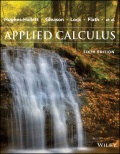
EBK APPLIED CALCULUS, ENHANCED ETEXT
6th Edition
ISBN: 9781119399353
Author: DA
Publisher: JOHN WILEY+SONS,INC.-CONSIGNMENT
expand_more
expand_more
format_list_bulleted
Concept explainers
Question
Chapter 10.2, Problem 3P
To determine
(a)
Find the present value of the annuity if it makes ten payments.
To determine
(b)
Find the present value of the annuity if it makes payments in perpetuity.
Expert Solution & Answer
Want to see the full answer?
Check out a sample textbook solution
Students have asked these similar questions
i need help please
i need help please
slove the initial-value problem.
y'' + 7y' + 12y = 0, y(0) = 2, y'(0) = 8
Chapter 10 Solutions
EBK APPLIED CALCULUS, ENHANCED ETEXT
Ch. 10.1 - Prob. 1PCh. 10.1 - Prob. 2PCh. 10.1 - Prob. 3PCh. 10.1 - Prob. 4PCh. 10.1 - Prob. 5PCh. 10.1 - Prob. 6PCh. 10.1 - Prob. 7PCh. 10.1 - Prob. 8PCh. 10.1 - Prob. 9PCh. 10.1 - Prob. 10P
Ch. 10.1 - Prob. 11PCh. 10.1 - Prob. 12PCh. 10.1 - Prob. 13PCh. 10.1 - Prob. 14PCh. 10.1 - Prob. 15PCh. 10.1 - Prob. 16PCh. 10.1 - Prob. 17PCh. 10.1 - Prob. 18PCh. 10.1 - Prob. 19PCh. 10.1 - Prob. 20PCh. 10.1 - Prob. 21PCh. 10.1 - Prob. 22PCh. 10.1 - Prob. 23PCh. 10.1 - Prob. 24PCh. 10.1 - Prob. 25PCh. 10.1 - Prob. 26PCh. 10.1 - Prob. 27PCh. 10.1 - Prob. 28PCh. 10.1 - Prob. 29PCh. 10.1 - Prob. 30PCh. 10.2 - Prob. 1PCh. 10.2 - Prob. 2PCh. 10.2 - Prob. 3PCh. 10.2 - Prob. 4PCh. 10.2 - Prob. 5PCh. 10.2 - Prob. 6PCh. 10.2 - Prob. 7PCh. 10.2 - Prob. 8PCh. 10.2 - Prob. 9PCh. 10.2 - Prob. 10PCh. 10.2 - Prob. 11PCh. 10.2 - Prob. 12PCh. 10.2 - Prob. 13PCh. 10.2 - Prob. 14PCh. 10.2 - Prob. 15PCh. 10.2 - Prob. 16PCh. 10.2 - Prob. 17PCh. 10.2 - Prob. 18PCh. 10.2 - Prob. 19PCh. 10.2 - Prob. 20PCh. 10.3 - Prob. 1PCh. 10.3 - Prob. 2PCh. 10.3 - Prob. 3PCh. 10.3 - Prob. 4PCh. 10.3 - Prob. 5PCh. 10.3 - Prob. 6PCh. 10.3 - Prob. 7PCh. 10.3 - Prob. 8PCh. 10.3 - Prob. 9PCh. 10.3 - Prob. 10PCh. 10.3 - Prob. 11PCh. 10.3 - Prob. 12PCh. 10.3 - Prob. 13PCh. 10.3 - Prob. 14PCh. 10.3 - Prob. 15PCh. 10.3 - Prob. 16PCh. 10.3 - Prob. 17PCh. 10.3 - Prob. 18PCh. 10.3 - Prob. 19PCh. 10.3 - Prob. 20PCh. 10 - Prob. 1SYUCh. 10 - Prob. 2SYUCh. 10 - Prob. 3SYUCh. 10 - Prob. 4SYUCh. 10 - Prob. 5SYUCh. 10 - Prob. 6SYUCh. 10 - Prob. 7SYUCh. 10 - Prob. 8SYUCh. 10 - Prob. 9SYUCh. 10 - Prob. 10SYUCh. 10 - Prob. 11SYUCh. 10 - Prob. 12SYUCh. 10 - Prob. 13SYUCh. 10 - Prob. 14SYUCh. 10 - Prob. 15SYUCh. 10 - Prob. 16SYUCh. 10 - Prob. 17SYUCh. 10 - Prob. 18SYUCh. 10 - Prob. 19SYUCh. 10 - Prob. 20SYUCh. 10 - Prob. 21SYUCh. 10 - Prob. 22SYUCh. 10 - Prob. 23SYUCh. 10 - Prob. 24SYUCh. 10 - Prob. 25SYUCh. 10 - Prob. 26SYUCh. 10 - Prob. 27SYUCh. 10 - Prob. 28SYUCh. 10 - Prob. 29SYUCh. 10 - Prob. 30SYU
Knowledge Booster
Learn more about
Need a deep-dive on the concept behind this application? Look no further. Learn more about this topic, calculus and related others by exploring similar questions and additional content below.Similar questions
- Prove that if a and b are both positive, then y(x)⭢0 as x⭢∞ for all sloutions y of the questionarrow_forwardShow how to use "Change of Variables Formula for Integrals" to solve "Separable Differential Equations"arrow_forwardUse the two methods "real number solution space basis" and "complex solution space basis" respectively to solve y''+ 4y' + 4y = 0, y(-1) = 2, y'(-1) = 1arrow_forward
- Explain the key points of Theroem 9.3.6arrow_forwardUse the two methods "real number solution space basis" and "complex solution space basis" respectively to solve y''+ 4y' + 4y = 0, y(-1) = 2, y'(-1) = 1arrow_forwardShow how to use "Change of Variables Formula for Integrals" to solve "Separable Differential Equations"arrow_forward
- A helicopter pilot needs to travel to a regional airport 25 miles away. She flies at an actual heading of N16.26°E with an airspeed of 110 mph, and there is a wind blowing directly east at 20 mph. (a) Determine the compass heading that the pilot needs to reach her destination. (b) How long will it take her to reach her destination?arrow_forwardQuestion 3. the given integral is convergent or divergent: Use the comparison test to determine whether or not * sin*(x + 1) 7x3 (a) |. d.x g8 + x4 + 1 -dx (b) 2.x4 + x + 1arrow_forward-d.x tan xarrow_forward
arrow_back_ios
SEE MORE QUESTIONS
arrow_forward_ios
Recommended textbooks for you

 College AlgebraAlgebraISBN:9781305115545Author:James Stewart, Lothar Redlin, Saleem WatsonPublisher:Cengage Learning
College AlgebraAlgebraISBN:9781305115545Author:James Stewart, Lothar Redlin, Saleem WatsonPublisher:Cengage Learning Algebra and Trigonometry (MindTap Course List)AlgebraISBN:9781305071742Author:James Stewart, Lothar Redlin, Saleem WatsonPublisher:Cengage Learning
Algebra and Trigonometry (MindTap Course List)AlgebraISBN:9781305071742Author:James Stewart, Lothar Redlin, Saleem WatsonPublisher:Cengage Learning


College Algebra
Algebra
ISBN:9781305115545
Author:James Stewart, Lothar Redlin, Saleem Watson
Publisher:Cengage Learning

Algebra and Trigonometry (MindTap Course List)
Algebra
ISBN:9781305071742
Author:James Stewart, Lothar Redlin, Saleem Watson
Publisher:Cengage Learning
Use of ALGEBRA in REAL LIFE; Author: Fast and Easy Maths !;https://www.youtube.com/watch?v=9_PbWFpvkDc;License: Standard YouTube License, CC-BY
Compound Interest Formula Explained, Investment, Monthly & Continuously, Word Problems, Algebra; Author: The Organic Chemistry Tutor;https://www.youtube.com/watch?v=P182Abv3fOk;License: Standard YouTube License, CC-BY
Applications of Algebra (Digit, Age, Work, Clock, Mixture and Rate Problems); Author: EngineerProf PH;https://www.youtube.com/watch?v=Y8aJ_wYCS2g;License: Standard YouTube License, CC-BY